Analysis of Orlando's Deliberate Nursing Process in Clinical Practice
VerifiedAdded on 2023/04/24
|10
|2486
|335
Report
AI Summary
This report provides a critical analysis of Orlando's Deliberate Nursing Process, a middle-range nursing theory. The paper begins with an introduction to nursing theories and the evolution of their development, emphasizing the shift from grand theories to middle-range theories. It then delves into Orlando's theory, outlining its core concepts such as the function of professional nursing, presenting behavior, immediate action, nursing process discipline, and improvement. The report includes a discussion of the theory's application in clinical practice, supported by relevant research findings, and a case study involving an elderly patient post-hip replacement surgery. The author uses this scenario to demonstrate how the theory can be applied to identify and address patient needs. Finally, the report provides a critical appraisal of the theory's adequacy, assessing its clarity, simplicity, generality, accessibility, and importance, based on the questions of Chin & Kramer. The report concludes by summarizing the key aspects of Orlando's nursing process theory and its value in guiding nursing practice.
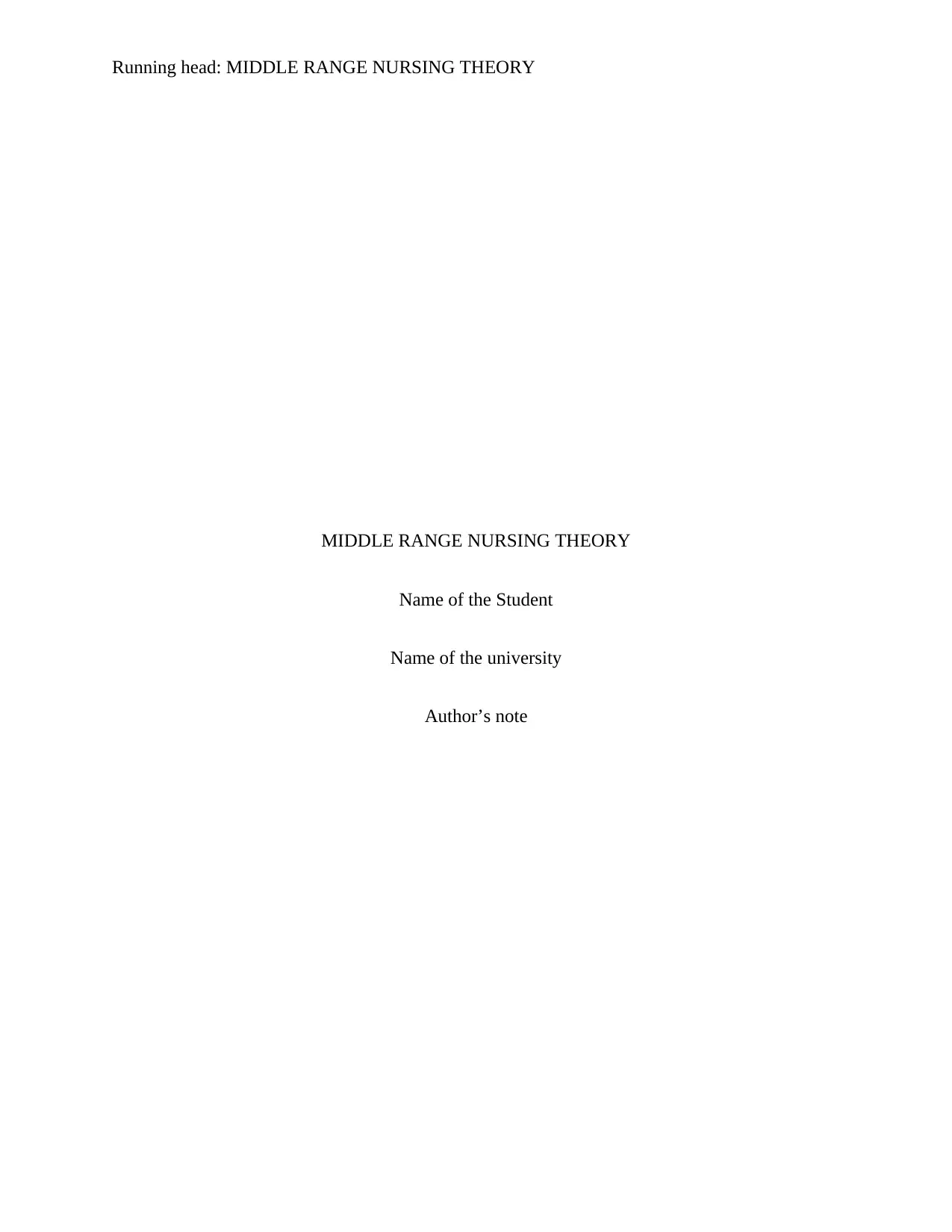
Running head: MIDDLE RANGE NURSING THEORY
MIDDLE RANGE NURSING THEORY
Name of the Student
Name of the university
Author’s note
MIDDLE RANGE NURSING THEORY
Name of the Student
Name of the university
Author’s note
Paraphrase This Document
Need a fresh take? Get an instant paraphrase of this document with our AI Paraphraser
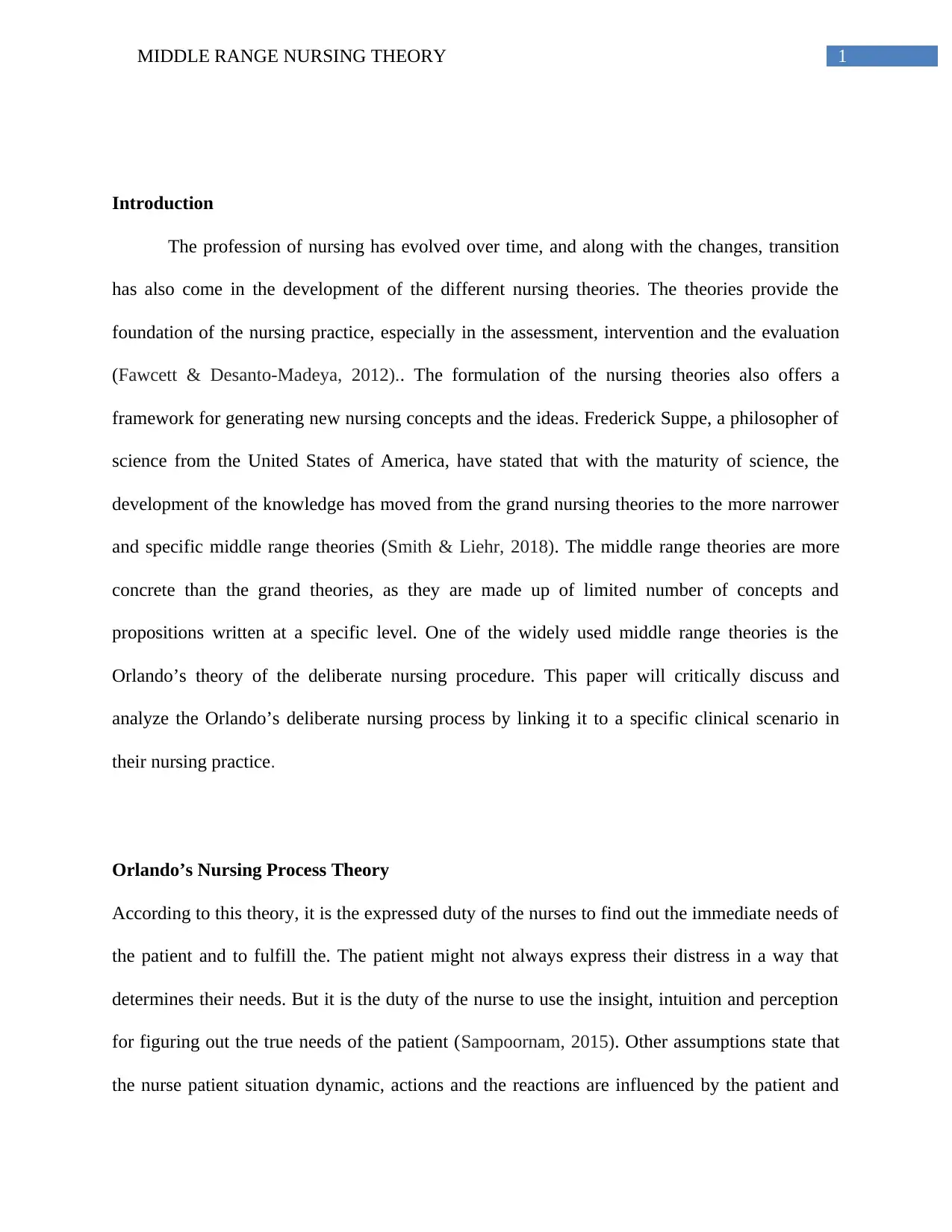
1MIDDLE RANGE NURSING THEORY
Introduction
The profession of nursing has evolved over time, and along with the changes, transition
has also come in the development of the different nursing theories. The theories provide the
foundation of the nursing practice, especially in the assessment, intervention and the evaluation
(Fawcett & Desanto-Madeya, 2012).. The formulation of the nursing theories also offers a
framework for generating new nursing concepts and the ideas. Frederick Suppe, a philosopher of
science from the United States of America, have stated that with the maturity of science, the
development of the knowledge has moved from the grand nursing theories to the more narrower
and specific middle range theories (Smith & Liehr, 2018). The middle range theories are more
concrete than the grand theories, as they are made up of limited number of concepts and
propositions written at a specific level. One of the widely used middle range theories is the
Orlando’s theory of the deliberate nursing procedure. This paper will critically discuss and
analyze the Orlando’s deliberate nursing process by linking it to a specific clinical scenario in
their nursing practice.
Orlando’s Nursing Process Theory
According to this theory, it is the expressed duty of the nurses to find out the immediate needs of
the patient and to fulfill the. The patient might not always express their distress in a way that
determines their needs. But it is the duty of the nurse to use the insight, intuition and perception
for figuring out the true needs of the patient (Sampoornam, 2015). Other assumptions state that
the nurse patient situation dynamic, actions and the reactions are influenced by the patient and
Introduction
The profession of nursing has evolved over time, and along with the changes, transition
has also come in the development of the different nursing theories. The theories provide the
foundation of the nursing practice, especially in the assessment, intervention and the evaluation
(Fawcett & Desanto-Madeya, 2012).. The formulation of the nursing theories also offers a
framework for generating new nursing concepts and the ideas. Frederick Suppe, a philosopher of
science from the United States of America, have stated that with the maturity of science, the
development of the knowledge has moved from the grand nursing theories to the more narrower
and specific middle range theories (Smith & Liehr, 2018). The middle range theories are more
concrete than the grand theories, as they are made up of limited number of concepts and
propositions written at a specific level. One of the widely used middle range theories is the
Orlando’s theory of the deliberate nursing procedure. This paper will critically discuss and
analyze the Orlando’s deliberate nursing process by linking it to a specific clinical scenario in
their nursing practice.
Orlando’s Nursing Process Theory
According to this theory, it is the expressed duty of the nurses to find out the immediate needs of
the patient and to fulfill the. The patient might not always express their distress in a way that
determines their needs. But it is the duty of the nurse to use the insight, intuition and perception
for figuring out the true needs of the patient (Sampoornam, 2015). Other assumptions state that
the nurse patient situation dynamic, actions and the reactions are influenced by the patient and
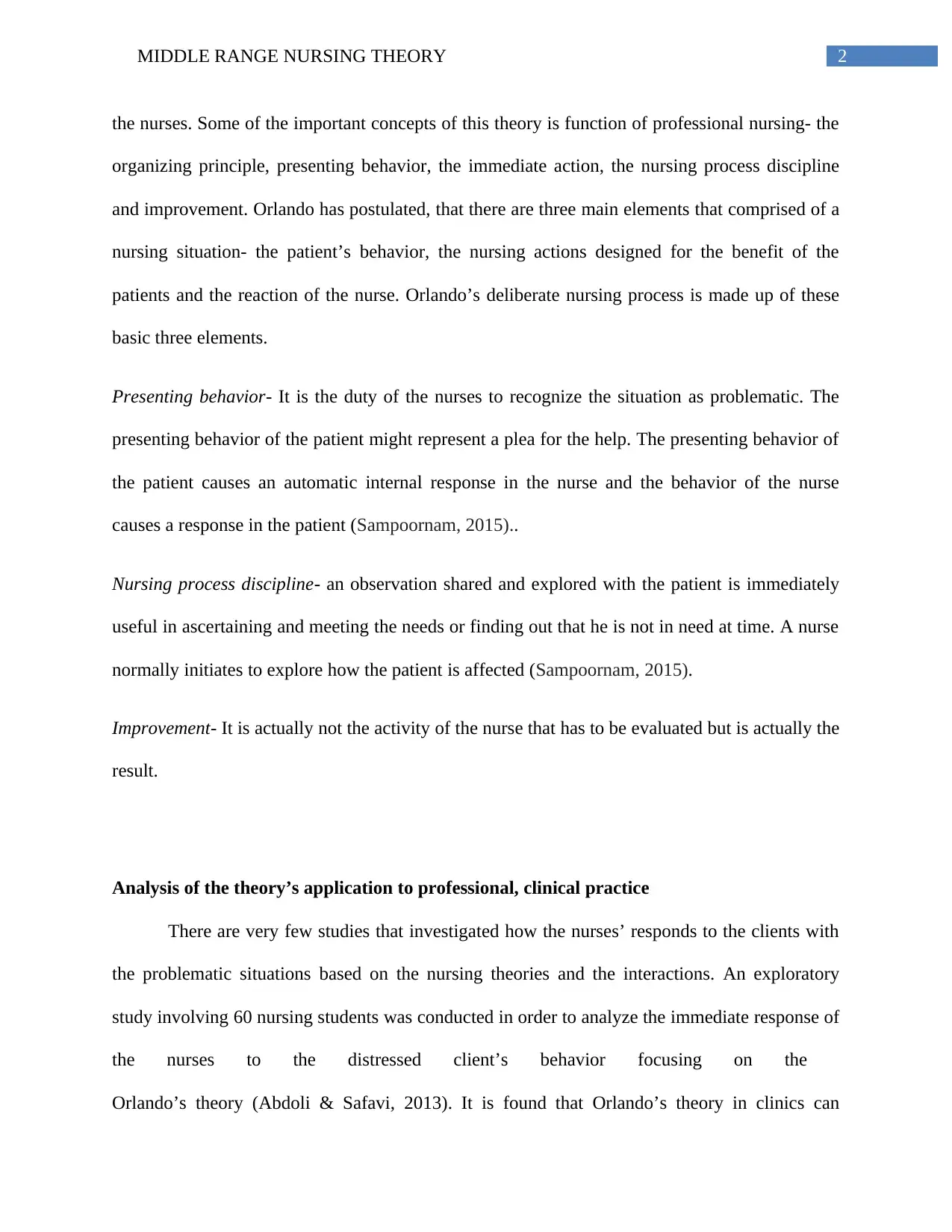
2MIDDLE RANGE NURSING THEORY
the nurses. Some of the important concepts of this theory is function of professional nursing- the
organizing principle, presenting behavior, the immediate action, the nursing process discipline
and improvement. Orlando has postulated, that there are three main elements that comprised of a
nursing situation- the patient’s behavior, the nursing actions designed for the benefit of the
patients and the reaction of the nurse. Orlando’s deliberate nursing process is made up of these
basic three elements.
Presenting behavior- It is the duty of the nurses to recognize the situation as problematic. The
presenting behavior of the patient might represent a plea for the help. The presenting behavior of
the patient causes an automatic internal response in the nurse and the behavior of the nurse
causes a response in the patient (Sampoornam, 2015)..
Nursing process discipline- an observation shared and explored with the patient is immediately
useful in ascertaining and meeting the needs or finding out that he is not in need at time. A nurse
normally initiates to explore how the patient is affected (Sampoornam, 2015).
Improvement- It is actually not the activity of the nurse that has to be evaluated but is actually the
result.
Analysis of the theory’s application to professional, clinical practice
There are very few studies that investigated how the nurses’ responds to the clients with
the problematic situations based on the nursing theories and the interactions. An exploratory
study involving 60 nursing students was conducted in order to analyze the immediate response of
the nurses to the distressed client’s behavior focusing on the
Orlando’s theory (Abdoli & Safavi, 2013). It is found that Orlando’s theory in clinics can
the nurses. Some of the important concepts of this theory is function of professional nursing- the
organizing principle, presenting behavior, the immediate action, the nursing process discipline
and improvement. Orlando has postulated, that there are three main elements that comprised of a
nursing situation- the patient’s behavior, the nursing actions designed for the benefit of the
patients and the reaction of the nurse. Orlando’s deliberate nursing process is made up of these
basic three elements.
Presenting behavior- It is the duty of the nurses to recognize the situation as problematic. The
presenting behavior of the patient might represent a plea for the help. The presenting behavior of
the patient causes an automatic internal response in the nurse and the behavior of the nurse
causes a response in the patient (Sampoornam, 2015)..
Nursing process discipline- an observation shared and explored with the patient is immediately
useful in ascertaining and meeting the needs or finding out that he is not in need at time. A nurse
normally initiates to explore how the patient is affected (Sampoornam, 2015).
Improvement- It is actually not the activity of the nurse that has to be evaluated but is actually the
result.
Analysis of the theory’s application to professional, clinical practice
There are very few studies that investigated how the nurses’ responds to the clients with
the problematic situations based on the nursing theories and the interactions. An exploratory
study involving 60 nursing students was conducted in order to analyze the immediate response of
the nurses to the distressed client’s behavior focusing on the
Orlando’s theory (Abdoli & Safavi, 2013). It is found that Orlando’s theory in clinics can
⊘ This is a preview!⊘
Do you want full access?
Subscribe today to unlock all pages.

Trusted by 1+ million students worldwide

3MIDDLE RANGE NURSING THEORY
enhance, nurse patient relationship and decreases distress among the patients. According to the
Orlando’s theory, emphasis should be put on the behavior of the client (problematic situation),
the immediate responses of the nurses and the nurses’ behavior (solution to the problem). The
nurses should consider the behavior of the client as the needs that have not been met (May,
2013). According to Orlando’s concept of nursing, the nurses’ immediate response to the
physical and the mental problem of the distressed clients were classified in to 6 main categories-
Physical caring, assuring, uncertainty, recommending, asking information and explaining. It was
found that most of the frequent responses to the client’s behavior is the physical caring, assuring
and recommending (May, 2013). This indicates towards the fact, that most of nurses actually do
not follow the theories. Hence, there is a need to make the theories more realistic such that they
can be applied to the clinical practice.
However, In a clinical placement, the writer was the assigned to take care of an elderly
patient, who had undergone a hip-replacement surgery and had displayed mild symptom of
dementia. It should be remembered that dementia is a neurodegenerative disorder that, might
restrict some adults to express their grievances as they are faced with several challenging clinical
manifestations like short term memory loss or other disruptive behavior. The writer at first
introduced herself to the patient and started taking her vital signs. On not getting any useful
response from the patient, the writer tried to assess the body language of the patents. Alarmed by
the facial grimacing of the patients, the writer understood that the patient is still experiencing
pain. Hence, complying with the first element of the Orlando’s theory, “analyzing the patient’s
behavior”, where a nurse should be able to understand the grievances of the patient, even if
he/she does not express it. The writer then assisted the patient to lay down in a comfortable
position. Apart from giving analgesics, the nurse provided him with psychological support by
enhance, nurse patient relationship and decreases distress among the patients. According to the
Orlando’s theory, emphasis should be put on the behavior of the client (problematic situation),
the immediate responses of the nurses and the nurses’ behavior (solution to the problem). The
nurses should consider the behavior of the client as the needs that have not been met (May,
2013). According to Orlando’s concept of nursing, the nurses’ immediate response to the
physical and the mental problem of the distressed clients were classified in to 6 main categories-
Physical caring, assuring, uncertainty, recommending, asking information and explaining. It was
found that most of the frequent responses to the client’s behavior is the physical caring, assuring
and recommending (May, 2013). This indicates towards the fact, that most of nurses actually do
not follow the theories. Hence, there is a need to make the theories more realistic such that they
can be applied to the clinical practice.
However, In a clinical placement, the writer was the assigned to take care of an elderly
patient, who had undergone a hip-replacement surgery and had displayed mild symptom of
dementia. It should be remembered that dementia is a neurodegenerative disorder that, might
restrict some adults to express their grievances as they are faced with several challenging clinical
manifestations like short term memory loss or other disruptive behavior. The writer at first
introduced herself to the patient and started taking her vital signs. On not getting any useful
response from the patient, the writer tried to assess the body language of the patents. Alarmed by
the facial grimacing of the patients, the writer understood that the patient is still experiencing
pain. Hence, complying with the first element of the Orlando’s theory, “analyzing the patient’s
behavior”, where a nurse should be able to understand the grievances of the patient, even if
he/she does not express it. The writer then assisted the patient to lay down in a comfortable
position. Apart from giving analgesics, the nurse provided him with psychological support by
Paraphrase This Document
Need a fresh take? Get an instant paraphrase of this document with our AI Paraphraser
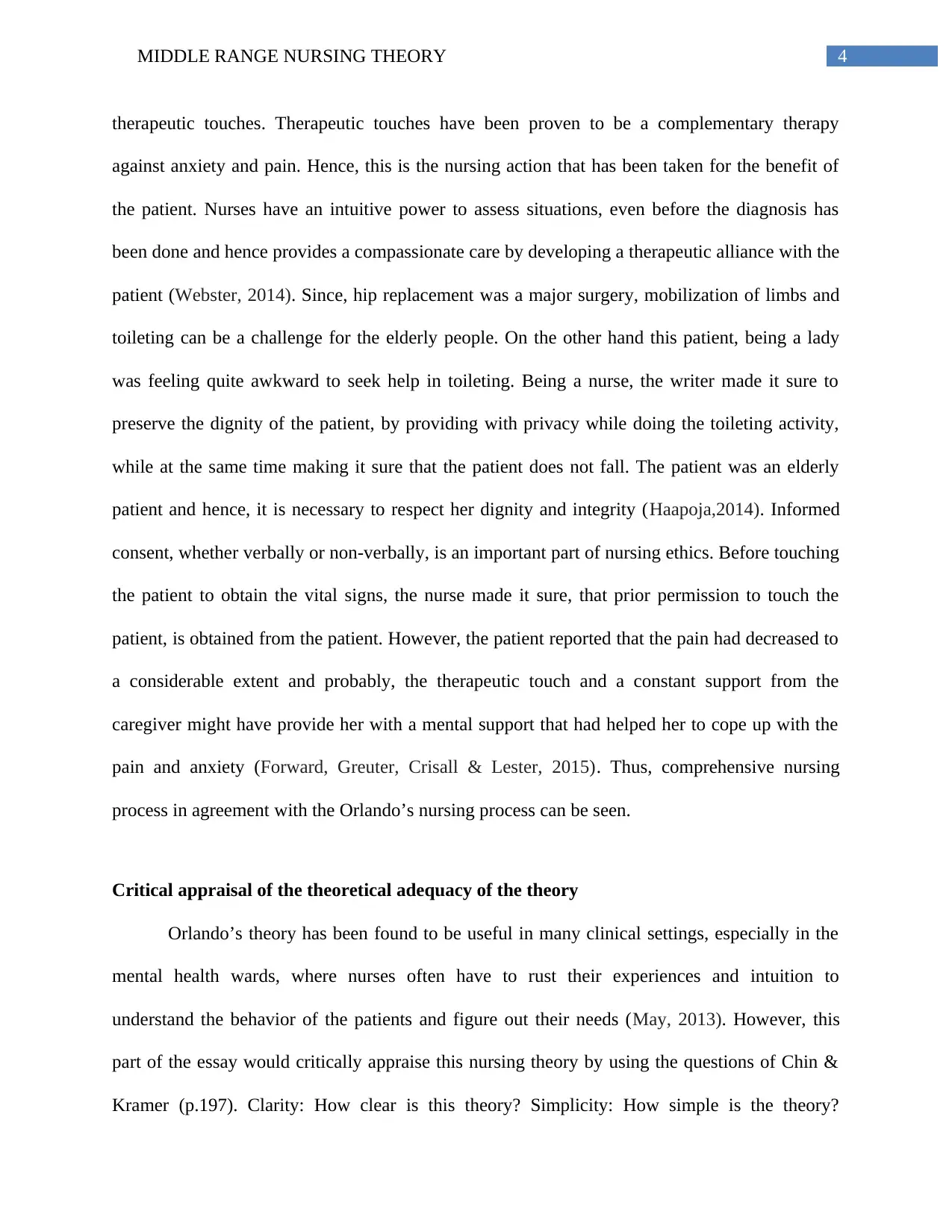
4MIDDLE RANGE NURSING THEORY
therapeutic touches. Therapeutic touches have been proven to be a complementary therapy
against anxiety and pain. Hence, this is the nursing action that has been taken for the benefit of
the patient. Nurses have an intuitive power to assess situations, even before the diagnosis has
been done and hence provides a compassionate care by developing a therapeutic alliance with the
patient (Webster, 2014). Since, hip replacement was a major surgery, mobilization of limbs and
toileting can be a challenge for the elderly people. On the other hand this patient, being a lady
was feeling quite awkward to seek help in toileting. Being a nurse, the writer made it sure to
preserve the dignity of the patient, by providing with privacy while doing the toileting activity,
while at the same time making it sure that the patient does not fall. The patient was an elderly
patient and hence, it is necessary to respect her dignity and integrity (Haapoja,2014). Informed
consent, whether verbally or non-verbally, is an important part of nursing ethics. Before touching
the patient to obtain the vital signs, the nurse made it sure, that prior permission to touch the
patient, is obtained from the patient. However, the patient reported that the pain had decreased to
a considerable extent and probably, the therapeutic touch and a constant support from the
caregiver might have provide her with a mental support that had helped her to cope up with the
pain and anxiety (Forward, Greuter, Crisall & Lester, 2015). Thus, comprehensive nursing
process in agreement with the Orlando’s nursing process can be seen.
Critical appraisal of the theoretical adequacy of the theory
Orlando’s theory has been found to be useful in many clinical settings, especially in the
mental health wards, where nurses often have to rust their experiences and intuition to
understand the behavior of the patients and figure out their needs (May, 2013). However, this
part of the essay would critically appraise this nursing theory by using the questions of Chin &
Kramer (p.197). Clarity: How clear is this theory? Simplicity: How simple is the theory?
therapeutic touches. Therapeutic touches have been proven to be a complementary therapy
against anxiety and pain. Hence, this is the nursing action that has been taken for the benefit of
the patient. Nurses have an intuitive power to assess situations, even before the diagnosis has
been done and hence provides a compassionate care by developing a therapeutic alliance with the
patient (Webster, 2014). Since, hip replacement was a major surgery, mobilization of limbs and
toileting can be a challenge for the elderly people. On the other hand this patient, being a lady
was feeling quite awkward to seek help in toileting. Being a nurse, the writer made it sure to
preserve the dignity of the patient, by providing with privacy while doing the toileting activity,
while at the same time making it sure that the patient does not fall. The patient was an elderly
patient and hence, it is necessary to respect her dignity and integrity (Haapoja,2014). Informed
consent, whether verbally or non-verbally, is an important part of nursing ethics. Before touching
the patient to obtain the vital signs, the nurse made it sure, that prior permission to touch the
patient, is obtained from the patient. However, the patient reported that the pain had decreased to
a considerable extent and probably, the therapeutic touch and a constant support from the
caregiver might have provide her with a mental support that had helped her to cope up with the
pain and anxiety (Forward, Greuter, Crisall & Lester, 2015). Thus, comprehensive nursing
process in agreement with the Orlando’s nursing process can be seen.
Critical appraisal of the theoretical adequacy of the theory
Orlando’s theory has been found to be useful in many clinical settings, especially in the
mental health wards, where nurses often have to rust their experiences and intuition to
understand the behavior of the patients and figure out their needs (May, 2013). However, this
part of the essay would critically appraise this nursing theory by using the questions of Chin &
Kramer (p.197). Clarity: How clear is this theory? Simplicity: How simple is the theory?
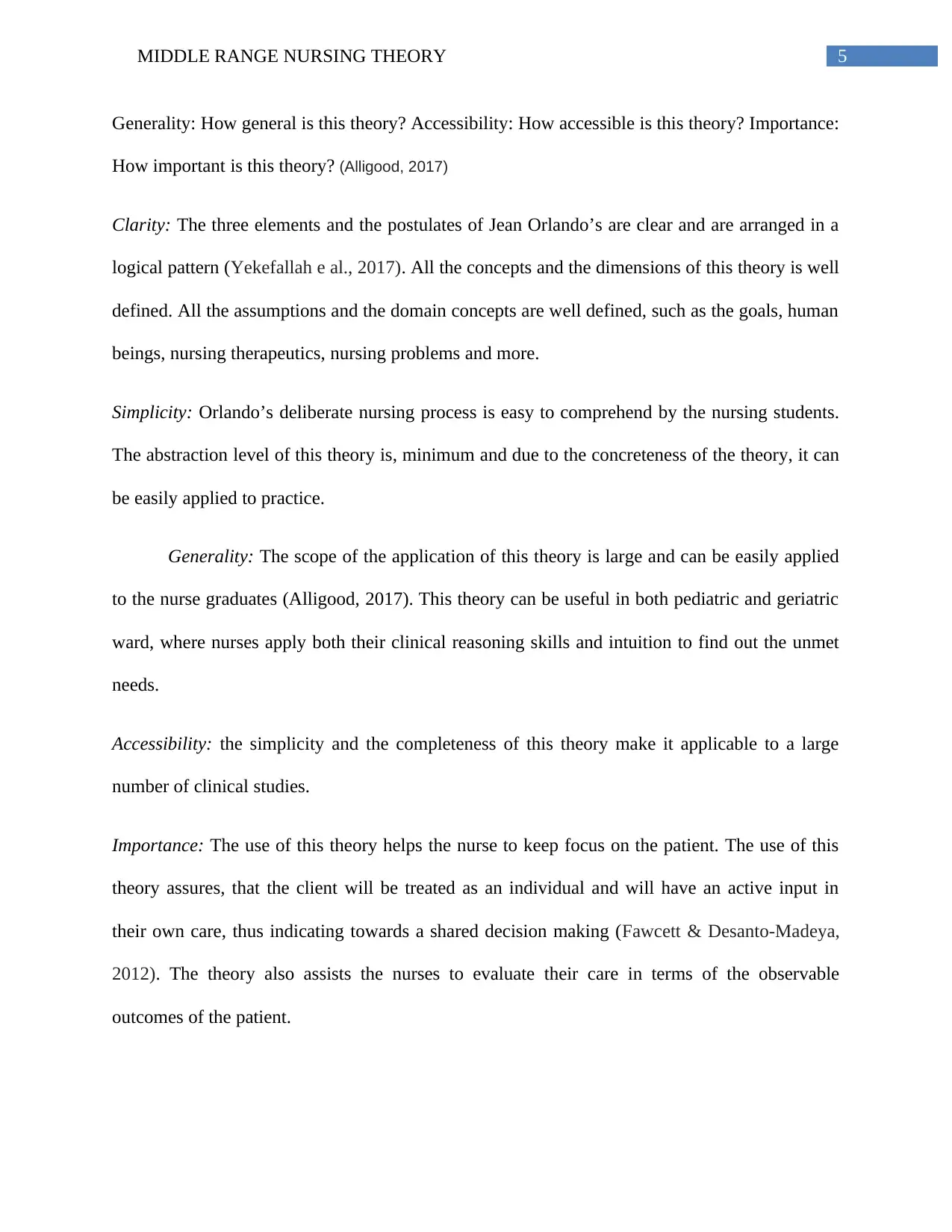
5MIDDLE RANGE NURSING THEORY
Generality: How general is this theory? Accessibility: How accessible is this theory? Importance:
How important is this theory? (Alligood, 2017)
Clarity: The three elements and the postulates of Jean Orlando’s are clear and are arranged in a
logical pattern (Yekefallah e al., 2017). All the concepts and the dimensions of this theory is well
defined. All the assumptions and the domain concepts are well defined, such as the goals, human
beings, nursing therapeutics, nursing problems and more.
Simplicity: Orlando’s deliberate nursing process is easy to comprehend by the nursing students.
The abstraction level of this theory is, minimum and due to the concreteness of the theory, it can
be easily applied to practice.
Generality: The scope of the application of this theory is large and can be easily applied
to the nurse graduates (Alligood, 2017). This theory can be useful in both pediatric and geriatric
ward, where nurses apply both their clinical reasoning skills and intuition to find out the unmet
needs.
Accessibility: the simplicity and the completeness of this theory make it applicable to a large
number of clinical studies.
Importance: The use of this theory helps the nurse to keep focus on the patient. The use of this
theory assures, that the client will be treated as an individual and will have an active input in
their own care, thus indicating towards a shared decision making (Fawcett & Desanto-Madeya,
2012). The theory also assists the nurses to evaluate their care in terms of the observable
outcomes of the patient.
Generality: How general is this theory? Accessibility: How accessible is this theory? Importance:
How important is this theory? (Alligood, 2017)
Clarity: The three elements and the postulates of Jean Orlando’s are clear and are arranged in a
logical pattern (Yekefallah e al., 2017). All the concepts and the dimensions of this theory is well
defined. All the assumptions and the domain concepts are well defined, such as the goals, human
beings, nursing therapeutics, nursing problems and more.
Simplicity: Orlando’s deliberate nursing process is easy to comprehend by the nursing students.
The abstraction level of this theory is, minimum and due to the concreteness of the theory, it can
be easily applied to practice.
Generality: The scope of the application of this theory is large and can be easily applied
to the nurse graduates (Alligood, 2017). This theory can be useful in both pediatric and geriatric
ward, where nurses apply both their clinical reasoning skills and intuition to find out the unmet
needs.
Accessibility: the simplicity and the completeness of this theory make it applicable to a large
number of clinical studies.
Importance: The use of this theory helps the nurse to keep focus on the patient. The use of this
theory assures, that the client will be treated as an individual and will have an active input in
their own care, thus indicating towards a shared decision making (Fawcett & Desanto-Madeya,
2012). The theory also assists the nurses to evaluate their care in terms of the observable
outcomes of the patient.
⊘ This is a preview!⊘
Do you want full access?
Subscribe today to unlock all pages.

Trusted by 1+ million students worldwide
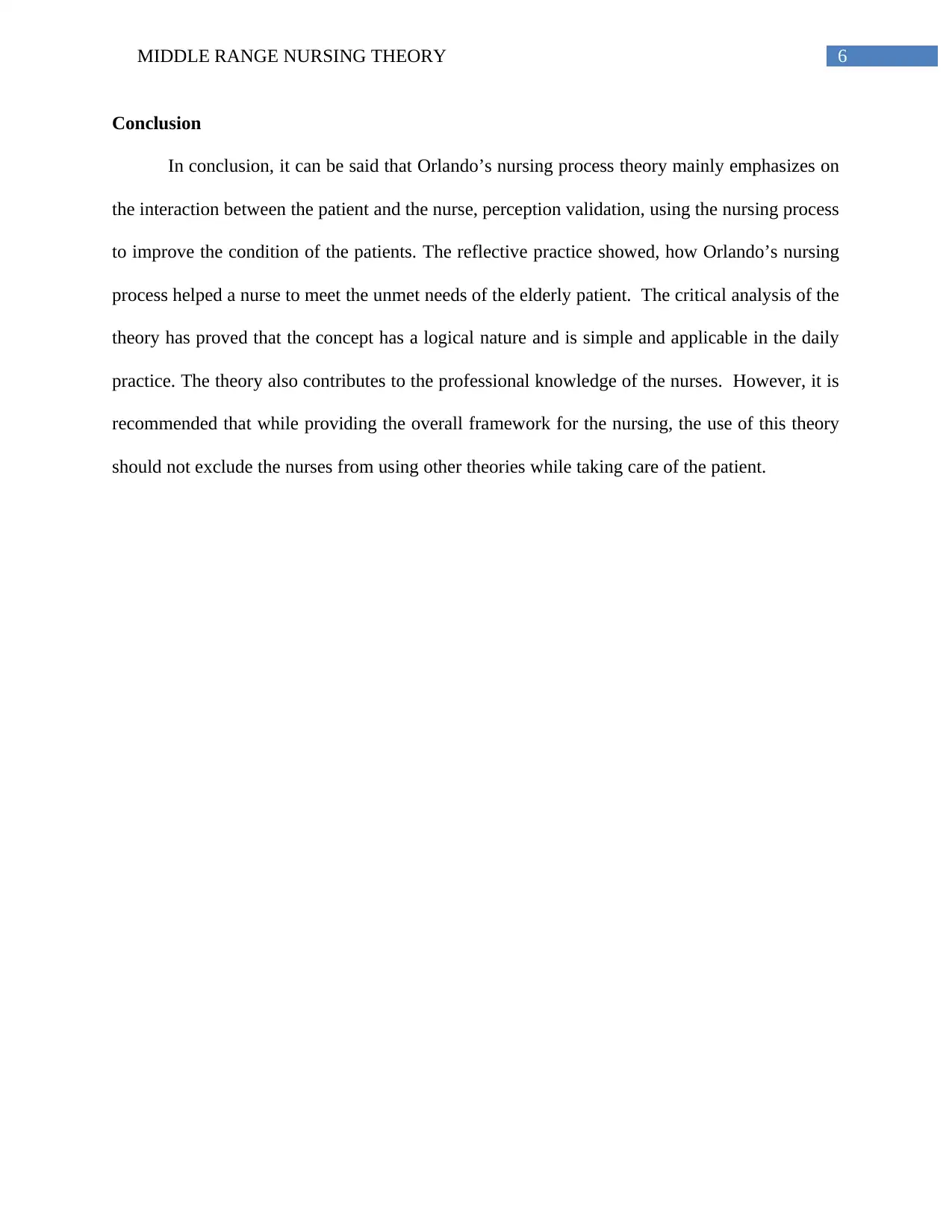
6MIDDLE RANGE NURSING THEORY
Conclusion
In conclusion, it can be said that Orlando’s nursing process theory mainly emphasizes on
the interaction between the patient and the nurse, perception validation, using the nursing process
to improve the condition of the patients. The reflective practice showed, how Orlando’s nursing
process helped a nurse to meet the unmet needs of the elderly patient. The critical analysis of the
theory has proved that the concept has a logical nature and is simple and applicable in the daily
practice. The theory also contributes to the professional knowledge of the nurses. However, it is
recommended that while providing the overall framework for the nursing, the use of this theory
should not exclude the nurses from using other theories while taking care of the patient.
Conclusion
In conclusion, it can be said that Orlando’s nursing process theory mainly emphasizes on
the interaction between the patient and the nurse, perception validation, using the nursing process
to improve the condition of the patients. The reflective practice showed, how Orlando’s nursing
process helped a nurse to meet the unmet needs of the elderly patient. The critical analysis of the
theory has proved that the concept has a logical nature and is simple and applicable in the daily
practice. The theory also contributes to the professional knowledge of the nurses. However, it is
recommended that while providing the overall framework for the nursing, the use of this theory
should not exclude the nurses from using other theories while taking care of the patient.
Paraphrase This Document
Need a fresh take? Get an instant paraphrase of this document with our AI Paraphraser

7MIDDLE RANGE NURSING THEORY
References
Abdoli, S., & Safavi, S. S. (2013). Nursing students' immediate responses to distressed clients
based on Orlando's theory. Iranian journal of nursing and midwifery research, 15(4), 178-
84. Retrieved from: https://www.ncbi.nlm.nih.gov/pmc/articles/PMC3093185/
Alligood, M. R. (2017). Nursing theorists and their work. Elsevier Health Sciences. Retrieved
from: https://books.google.co.in/books?
hl=en&lr=&id=l7stDwAAQBAJ&oi=fnd&pg=PP1&dq=+Theory+of+caring.+In+M.R.
+Alligood+(Ed.),
+Nursing+theorists+and+their+work+(8th+ed.).&ots=yVuHUVMRcc&sig=NS16-
QHvqKpmMp5ZNS6iiEjNVEY#v=onepage&q=Theory%20of%20caring.%20In
%20M.R.%20Alligood%20(Ed.)%2C%20Nursing%20theorists%20and%20their
%20work%20(8th%20ed.).&f=false
Fawcett, J., & Desanto-Madeya, S. (2012). Contemporary nursing knowledge: Analysis and
evaluation of nursing models and theories. FA Davis. Retrieved from:
https://books.google.co.in/books?hl=en&lr=&id=pdE-
AAAAQBAJ&oi=fnd&pg=PR4&dq=orlando
%27s+theory+of+deliberative+nursing+process&ots=jWCzFmmYhM&sig=M6bdMiw4c
iz7RuuHCenA1VL0Omw#v=onepage&q=orlando's%20theory%20of%20deliberative
%20nursing%20process&f=false
Forward, J. B., Greuter, N. E., Crisall, S. J., & Lester, H. F. (2015). Effect of structured touch
and guided imagery for pain and anxiety in elective joint replacement patients—a
References
Abdoli, S., & Safavi, S. S. (2013). Nursing students' immediate responses to distressed clients
based on Orlando's theory. Iranian journal of nursing and midwifery research, 15(4), 178-
84. Retrieved from: https://www.ncbi.nlm.nih.gov/pmc/articles/PMC3093185/
Alligood, M. R. (2017). Nursing theorists and their work. Elsevier Health Sciences. Retrieved
from: https://books.google.co.in/books?
hl=en&lr=&id=l7stDwAAQBAJ&oi=fnd&pg=PP1&dq=+Theory+of+caring.+In+M.R.
+Alligood+(Ed.),
+Nursing+theorists+and+their+work+(8th+ed.).&ots=yVuHUVMRcc&sig=NS16-
QHvqKpmMp5ZNS6iiEjNVEY#v=onepage&q=Theory%20of%20caring.%20In
%20M.R.%20Alligood%20(Ed.)%2C%20Nursing%20theorists%20and%20their
%20work%20(8th%20ed.).&f=false
Fawcett, J., & Desanto-Madeya, S. (2012). Contemporary nursing knowledge: Analysis and
evaluation of nursing models and theories. FA Davis. Retrieved from:
https://books.google.co.in/books?hl=en&lr=&id=pdE-
AAAAQBAJ&oi=fnd&pg=PR4&dq=orlando
%27s+theory+of+deliberative+nursing+process&ots=jWCzFmmYhM&sig=M6bdMiw4c
iz7RuuHCenA1VL0Omw#v=onepage&q=orlando's%20theory%20of%20deliberative
%20nursing%20process&f=false
Forward, J. B., Greuter, N. E., Crisall, S. J., & Lester, H. F. (2015). Effect of structured touch
and guided imagery for pain and anxiety in elective joint replacement patients—a

8MIDDLE RANGE NURSING THEORY
randomized controlled trial: M-TIJRP. The Permanente Journal, 19(4), 18.
doi: 10.7812/TPP/14-236
Haapoja, A. (2014). The nursing process, A tool to enhance clinical care–a Theoretical Study.
Retrieved from: http://urn.fi/URN:NBN:fi:amk-201405168246
May, B. A. (2013). Orlando’s Nursing Process Theory in Nursing Practice. Nursing Theory-E-
Book: Utilization & Application, 285. Retrieved from: https://books.google.co.in/books?
hl=en&lr=&id=adLsAwAAQBAJ&oi=fnd&pg=PA285&dq=orlando
%27s+theory+of+deliberative+nursing+process&ots=qtgETm7c6l&sig=zdc_Aik659ISZ
mCjB_jbWaVjKB4#v=onepage&q=orlando's%20theory%20of%20deliberative
%20nursing%20process&f=false
Sampoornam, W. (2015). Nursing process and Orlando process discipline-A case scenario. Asian
Journal of Nursing Education and Research, 5(2), 212. DOI: 10.5958/2349-
2996.2015.00042.7
Smith, M. J., & Liehr, P. R. (Eds.). (2018). Middle range theory for nursing. Springer Publishing
Company. Retrieved from: https://books.google.co.in/books?
hl=en&lr=&id=XN1JDwAAQBAJ&oi=fnd&pg=PP1&dq=middle+range+theories&ots=
hd8ZCroSuw&sig=1ky10W7u7b2cDuaXMgT42p9oeq4#v=onepage&q=middle
%20range%20theories&f=false
Webster, D. (2014). Using standardized patients to teach therapeutic communication in
psychiatric nursing. Clinical Simulation in Nursing, 10(2), e81-e86.
https://doi.org/10.1016/j.ecns.2013.08.005
randomized controlled trial: M-TIJRP. The Permanente Journal, 19(4), 18.
doi: 10.7812/TPP/14-236
Haapoja, A. (2014). The nursing process, A tool to enhance clinical care–a Theoretical Study.
Retrieved from: http://urn.fi/URN:NBN:fi:amk-201405168246
May, B. A. (2013). Orlando’s Nursing Process Theory in Nursing Practice. Nursing Theory-E-
Book: Utilization & Application, 285. Retrieved from: https://books.google.co.in/books?
hl=en&lr=&id=adLsAwAAQBAJ&oi=fnd&pg=PA285&dq=orlando
%27s+theory+of+deliberative+nursing+process&ots=qtgETm7c6l&sig=zdc_Aik659ISZ
mCjB_jbWaVjKB4#v=onepage&q=orlando's%20theory%20of%20deliberative
%20nursing%20process&f=false
Sampoornam, W. (2015). Nursing process and Orlando process discipline-A case scenario. Asian
Journal of Nursing Education and Research, 5(2), 212. DOI: 10.5958/2349-
2996.2015.00042.7
Smith, M. J., & Liehr, P. R. (Eds.). (2018). Middle range theory for nursing. Springer Publishing
Company. Retrieved from: https://books.google.co.in/books?
hl=en&lr=&id=XN1JDwAAQBAJ&oi=fnd&pg=PP1&dq=middle+range+theories&ots=
hd8ZCroSuw&sig=1ky10W7u7b2cDuaXMgT42p9oeq4#v=onepage&q=middle
%20range%20theories&f=false
Webster, D. (2014). Using standardized patients to teach therapeutic communication in
psychiatric nursing. Clinical Simulation in Nursing, 10(2), e81-e86.
https://doi.org/10.1016/j.ecns.2013.08.005
⊘ This is a preview!⊘
Do you want full access?
Subscribe today to unlock all pages.

Trusted by 1+ million students worldwide
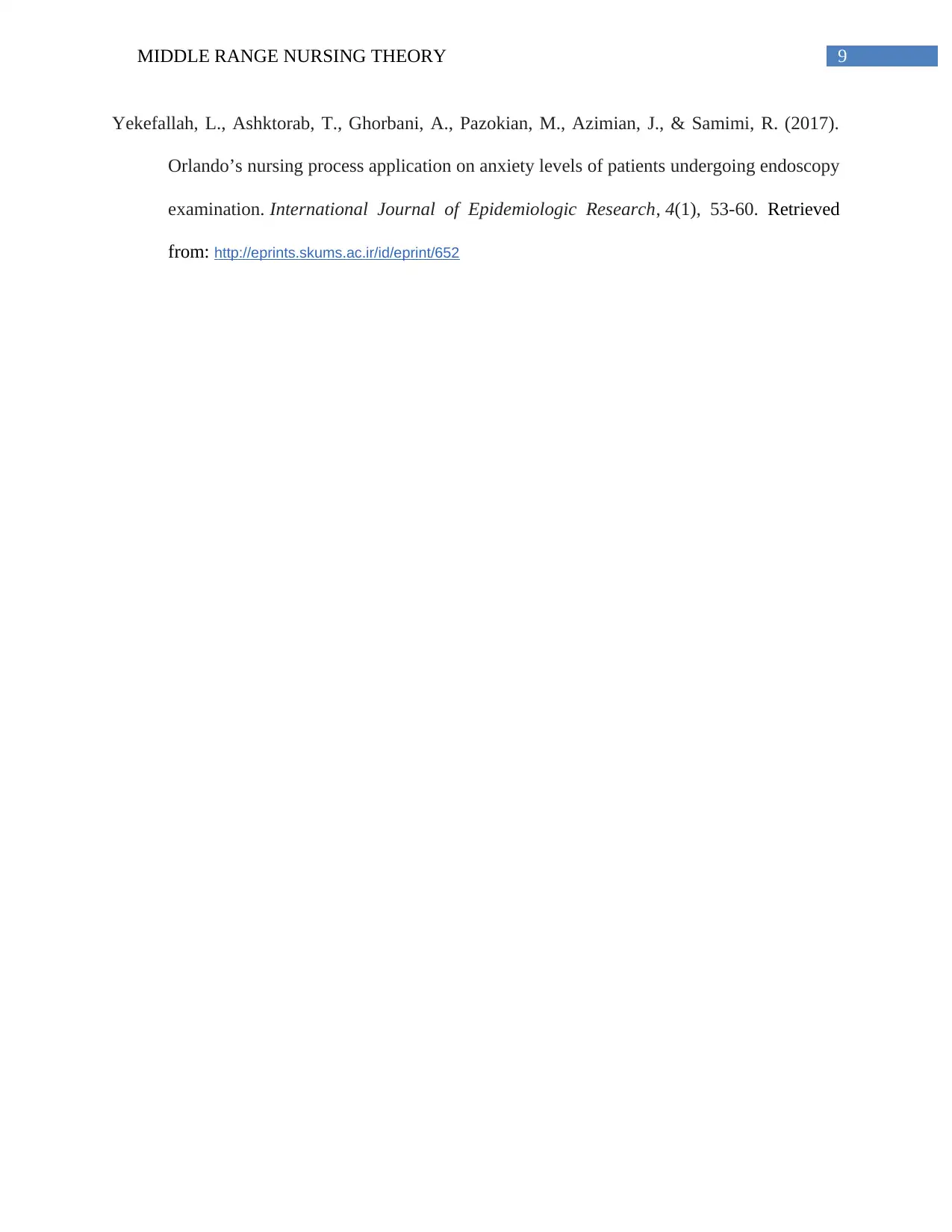
9MIDDLE RANGE NURSING THEORY
Yekefallah, L., Ashktorab, T., Ghorbani, A., Pazokian, M., Azimian, J., & Samimi, R. (2017).
Orlando’s nursing process application on anxiety levels of patients undergoing endoscopy
examination. International Journal of Epidemiologic Research, 4(1), 53-60. Retrieved
from: http://eprints.skums.ac.ir/id/eprint/652
Yekefallah, L., Ashktorab, T., Ghorbani, A., Pazokian, M., Azimian, J., & Samimi, R. (2017).
Orlando’s nursing process application on anxiety levels of patients undergoing endoscopy
examination. International Journal of Epidemiologic Research, 4(1), 53-60. Retrieved
from: http://eprints.skums.ac.ir/id/eprint/652
1 out of 10
Related Documents
Your All-in-One AI-Powered Toolkit for Academic Success.
+13062052269
info@desklib.com
Available 24*7 on WhatsApp / Email
![[object Object]](/_next/static/media/star-bottom.7253800d.svg)
Unlock your academic potential
Copyright © 2020–2025 A2Z Services. All Rights Reserved. Developed and managed by ZUCOL.





